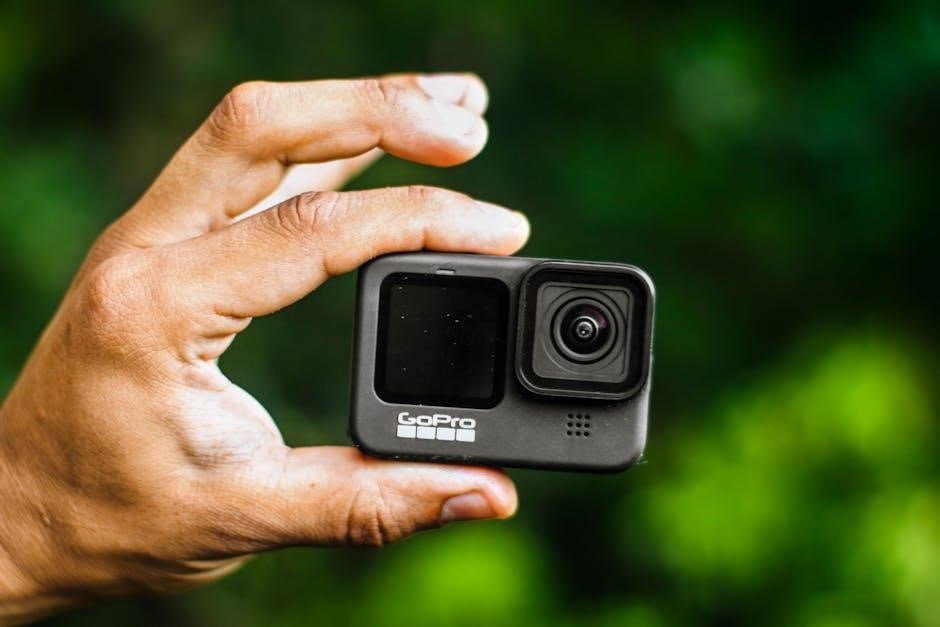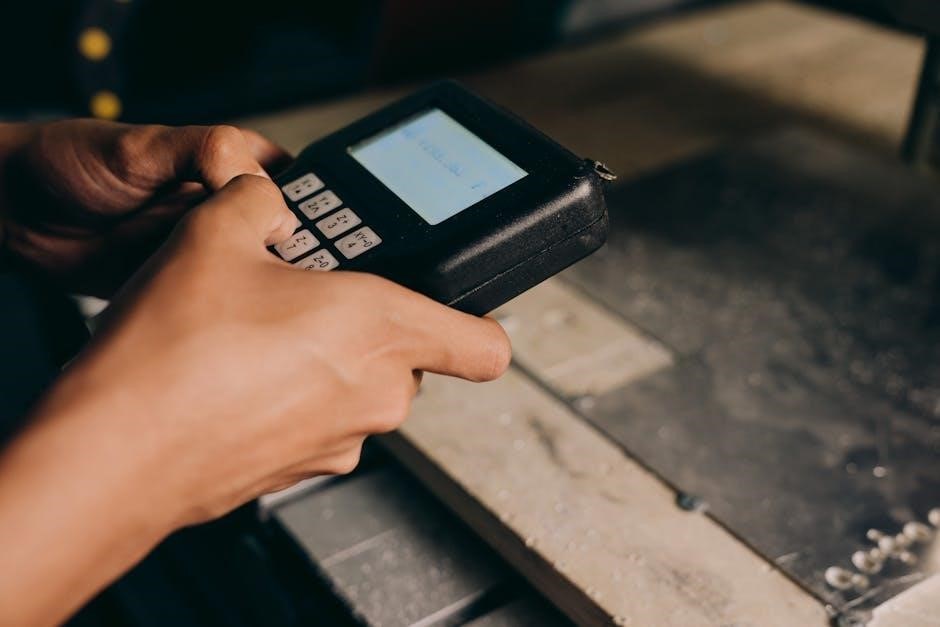Welcome to the Hunter Thermostat User Manual! This guide helps you understand and maximize your thermostat’s features, ensuring efficient heating and cooling for your home.
1.1 Overview of Hunter Thermostats
Hunter thermostats are designed to provide reliable and efficient temperature control for home heating and cooling systems. Known for their user-friendly interface and advanced features, these thermostats offer programmable settings, remote sensor compatibility, and energy-saving modes. With a focus on simplicity and functionality, Hunter thermostats cater to both residential and commercial needs. They support various HVAC systems, including gas, electronic ignition, and heat pumps. The thermostats are pre-programmed for optimal energy savings, making them a convenient choice for homeowners. Easy installation and detailed user manuals ensure a hassle-free experience. Whether you’re looking for basic temperature control or advanced smart features, Hunter thermostats deliver performance and efficiency.
1.2 Importance of Reading the User Manual
Reading the Hunter thermostat user manual is essential for optimal performance and functionality. The manual provides clear instructions for installation, programming, and customization, ensuring a seamless setup process. It includes detailed illustrations and step-by-step guides, making it easy to understand and use. The manual also covers troubleshooting tips and maintenance advice, helping you resolve issues quickly and extend the product’s lifespan. By following the manual, you can unlock all features, including energy-saving modes and remote sensor settings. Designed to be user-friendly, the manual empowers you to maximize your thermostat’s potential and enjoy efficient heating and cooling year-round.
Hunter Thermostat Models and Compatibility
Hunter offers various thermostat models, such as the 44150, 44150B, and 44550, designed to work seamlessly with gas, electric, and heat pump systems for optimal performance.
2.1 Popular Hunter Thermostat Models
Hunter offers a range of popular thermostat models, including the 44150, 44150B, and 44550. These models are known for their reliability and user-friendly interfaces. The 44150 and 44150B are designed for gas and electric systems, while the 44550 is suitable for heat pumps. Additionally, models like the 44378 7-Day Programmable Thermostat provide advanced scheduling options. These thermostats are compatible with various heating and cooling systems, ensuring efficient temperature control. By selecting the appropriate model, users can enjoy enhanced energy savings and customizable settings tailored to their home’s needs. Hunter’s diverse product line ensures there’s a thermostat for every household requirement.
2.2 Compatibility with Heating and Cooling Systems
Hunter thermostats are designed to work seamlessly with various heating and cooling systems. They are compatible with gas systems, including standing pilot and electronic ignition, as well as gas-fired boilers. Additionally, Hunter thermostats support heat pumps, ensuring efficient temperature control. However, they are not suitable for multi-stage heating or cooling systems, 110/220V systems, or 3-wire zone systems. Some models also support remote sensors, enhancing their ability to maintain consistent temperatures across different areas. This versatility makes Hunter thermostats a reliable choice for a wide range of home heating and cooling needs. Proper compatibility ensures optimal performance and energy efficiency.

Installation and Setup
Installing your Hunter thermostat is straightforward. Follow the detailed instructions in the manual for a seamless setup. Most models come pre-programmed for optimal performance.
3.1 Pre-Installation Requirements
Before installing your Hunter thermostat, ensure the power to your HVAC system is turned off at the circuit breaker. Gather necessary tools, including a screwdriver and wire labels. Check compatibility with your heating and cooling systems, as Hunter thermostats may not support multi-stage or 110/220V systems. Remove the old thermostat carefully, labeling wires to avoid confusion. Refer to the manual for specific model requirements, such as the 44150 or 44150b. Ensure the thermostat is suitable for your system type, like gas or heat pumps. If unsure, consult a professional or the user manual for guidance. Proper preparation ensures a smooth installation process.
3.2 Step-by-Step Installation Guide
To install your Hunter thermostat, start by turning off the power to your HVAC system at the circuit breaker. Remove the old thermostat and label the wires for easy identification. Mount the new thermostat base to the wall, ensuring it is level. Connect the wires according to the manual, matching the labels to the correct terminals. Secure the thermostat faceplate to the base and restore power. Test the system to ensure proper operation. If unsure, consult the user manual or contact Hunter’s technical support. Proper installation ensures your thermostat functions efficiently and safely. Always follow the manufacturer’s instructions for a successful setup.

Programming and Scheduling
This section guides you through setting up custom schedules and programming options for your Hunter thermostat, optimizing temperature control for comfort and energy efficiency.
4.1 Understanding the Programming Interface
The Hunter thermostat’s programming interface is designed for ease of use, featuring an intuitive touchscreen or button-controlled menu system. The LCD display provides clear options for setting schedules, adjusting temperatures, and accessing advanced settings. Users can navigate through various modes, such as heat, cool, or auto, and enable features like compressor protection. The interface also includes an energy-saving bar to help optimize efficiency. Remote sensor compatibility allows for multi-zone temperature control, enhancing comfort. Detailed instructions in the manual guide users through each step, ensuring seamless programming. With a user-friendly layout and clear instructions, the interface makes it easy to customize settings for optimal performance.
4.2 Setting Up Daily Schedules
Setting up daily schedules on your Hunter thermostat is straightforward, allowing you to customize temperature settings throughout the day. Start by accessing the programming menu, typically found under the main settings. From there, you can select the days of the week you wish to program and set specific periods such as wake, leave, return, and sleep. These periods enable you to maintain optimal temperatures during different times of the day. The interface guides you through setting start and end times, ensuring a seamless experience. Energy-saving modes can also be integrated into your schedule to reduce consumption. For added convenience, if you have remote sensors installed, they can be incorporated into your scheduling to maintain consistent temperatures across multiple zones. This feature not only enhances comfort but also helps in optimizing energy efficiency.

Features and Functions
The Hunter thermostat offers advanced features like remote sensor compatibility, energy-saving modes, and a user-friendly interface to optimize your home’s comfort and energy efficiency seamlessly.
5.1 Remote Sensor Compatibility
Hunter thermostats support remote sensors, enhancing temperature control accuracy. With compatibility for up to three sensors—two indoor and one outdoor—you can monitor and regulate temperatures across different zones. This feature allows for precise comfort management, ensuring optimal heating and cooling. The remote sensors integrate seamlessly with the thermostat, providing real-time data for automatic adjustments. Installation is straightforward, and the user manual offers detailed guidance. By utilizing remote sensors, you can achieve balanced temperature distribution and improved energy efficiency. This functionality is particularly beneficial for larger spaces or homes with varying temperature needs, ensuring consistent comfort throughout.
5.2 Energy-Saving Modes and Settings
Hunter thermostats offer advanced energy-saving modes designed to reduce consumption while maintaining comfort. Features like “Energy Saver” and “Auto” modes optimize heating and cooling by learning your schedule and preferences. The thermostat also includes adaptive recovery, which efficiently reaches your desired temperature at the set time. Additionally, some models support geofencing, adjusting settings based on your location. These modes work seamlessly with remote sensors to balance energy use and comfort. The user manual provides detailed instructions for activating and customizing these settings, ensuring you maximize efficiency without sacrificing convenience; By leveraging these features, users can significantly lower their energy bills while enjoying a comfortable home environment.

Maintenance and Troubleshooting
Regular maintenance ensures optimal performance and longevity of your Hunter thermostat. Cleaning the screen and checking wiring helps prevent issues. Troubleshooting common problems is easy with detailed guides.
6.1 Routine Maintenance Tips
Regular maintenance is crucial for ensuring your Hunter thermostat operates efficiently. Start by cleaning the display screen gently with a soft cloth to prevent dust buildup. Check and tighten all wiring connections to avoid electrical issues. Replace batteries annually if your model uses them. Inspect the thermostat’s sensors for accuracy and ensure they are free from obstructions. Additionally, update your thermostat’s software periodically to access the latest features and improvements. For advanced models, refer to the user manual for specific maintenance instructions tailored to your device. Following these routine tips will extend the lifespan of your thermostat and maintain optimal performance.
6.2 Common Issues and Solutions
Some common issues with Hunter thermostats include the device not turning on, incorrect temperature readings, or unresponsive displays. If your thermostat doesn’t power on, check the circuit breaker or ensure proper wiring connections. For inaccurate temperature readings, verify sensor calibration or clean the sensor. If the display is unresponsive, restart the thermostat or replace batteries if applicable. Connectivity issues with remote sensors can be resolved by ensuring they are within range and properly paired. For Wi-Fi disconnections, restart your router or check network stability. Refer to the user manual for detailed troubleshooting steps or contact Hunter’s technical support for assistance. Regular maintenance can prevent many of these issues.

Advanced Settings and Customization
Explore advanced settings like compressor protection delays and temperature limit adjustments to tailor your Hunter thermostat for optimal performance and energy efficiency.
7.1 Configuring Compressor Protection
The Hunter thermostat includes a compressor protection feature to prevent rapid cycling, which can damage your HVAC system. This setting ensures a 3.5-minute delay after shutting off the cooling system before restarting it. To configure compressor protection, navigate to the advanced settings menu and select the desired delay time. This feature is essential for maintaining system efficiency and longevity. Proper configuration prevents wear and tear on the compressor, ensuring reliable performance. Always refer to the user manual for specific instructions tailored to your model. Adjusting this setting incorrectly may affect system operation, so careful attention is recommended. This feature is a key component of Hunter thermostats’ energy-saving and protective capabilities.
7.2 Adjusting Temperature Limits
To adjust the temperature limits on your Hunter thermostat, navigate to the advanced settings menu. Select “Temperature Limits” to set minimum and maximum temperatures. The manual recommends a range of 40°F to 90°F. Enable “Auto Limits” for automatic adjustments based on heating or cooling modes. After setting your preferences, save the changes to ensure they are stored. Monitor the system to ensure it operates within the set limits. If issues arise, refer to the user manual or online troubleshooting guides for assistance. Proper adjustment ensures comfort and prevents potential damage to your HVAC system.
Energy Efficiency and Savings
Hunter thermostats offer energy-saving features like compressor protection and remote sensors, ensuring optimal efficiency and reduced energy consumption for long-term savings and environmental benefits.
8.1 Energy-Saving Features Explained
Hunter thermostats are designed with innovative energy-saving features to optimize your home’s heating and cooling systems. One key feature is the compressor protection, which prevents rapid cycling by introducing a delay between cooling cycles, reducing wear and tear. Additionally, Hunter thermostats support remote sensors, allowing you to monitor temperatures in multiple zones and adjust settings for energy efficiency. The adaptive recovery feature learns your system’s behavior to pre-heat or pre-cool your home, ensuring consistent comfort while minimizing energy use. These features work together to help you save on energy costs and reduce your environmental impact without compromising comfort.
8.2 Optimizing Settings for Maximum Efficiency
To achieve maximum efficiency with your Hunter thermostat, start by using the pre-programmed settings designed for optimal energy savings. Adjust the temperature range to balance comfort and energy use, ensuring it aligns with your daily schedule. For example, lower the temperature in winter or raise it in summer when the house is unoccupied. Use the energy-saving features like the energy saver bar to visualize energy consumption and make informed decisions. Regularly review and tweak your settings to reflect seasonal changes or lifestyle adjustments. By maintaining consistent, reasonable temperature settings and leveraging these features, you can significantly reduce energy waste while keeping your home comfortable year-round.
Your Hunter thermostat is designed to enhance comfort and efficiency. Regularly review and adjust settings to maximize energy savings. Happy heating and cooling!
9.1 Summary of Key Features
The Hunter thermostat offers a range of innovative features designed to enhance comfort and energy efficiency. Key features include remote sensor compatibility, energy-saving modes, and advanced programming options. The thermostat supports multi-stage heating and cooling systems, ensuring optimal performance. Additionally, it includes compressor protection, temperature limits adjustment, and a user-friendly interface for easy operation. With pre-programmed settings for energy savings, the thermostat minimizes manual adjustments. Remote sensors allow temperature monitoring from multiple locations, while the lockout feature prevents unauthorized changes. These features collectively ensure a seamless and efficient heating and cooling experience, making the Hunter thermostat a reliable choice for modern homes.
9.2 Best Practices for Long-Term Use
For optimal performance and longevity, follow these best practices when using your Hunter thermostat. Regularly clean the thermostat and ensure proper installation to avoid connectivity issues. Schedule routine maintenance, such as checking remote sensors and updating software, to maintain accuracy and functionality. Avoid extreme temperature adjustments to prevent system strain. Use energy-saving modes and pre-programmed schedules to reduce energy consumption. Reference the user manual for troubleshooting common issues and follow manufacturer guidelines for repairs. By adhering to these practices, you can ensure your Hunter thermostat operates efficiently, providing reliable comfort and energy savings for years to come.
